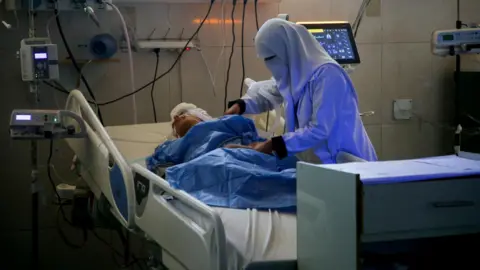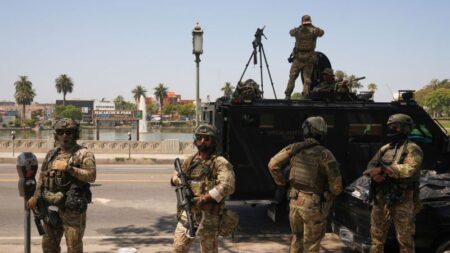In the midst of escalating violence in the region, Gaza’s largest operational medical facility, the Nasser Medical Complex, faces a grim crisis characterized by severe fuel shortages and a heightened Israeli ground offensive in the city of Khan Younis. Medical professionals have sounded alarms regarding the imminent risk of disaster at the hospital, as critical fuel supplies dwindle and direct military engagement intensifies in its vicinity. The situation came to a head on Thursday when the hospital was compelled to halt patient admissions, and witnesses reported that Israeli military forces, including tanks, were advancing dangerously close to the facility.
Nasser Medical Complex, which serves as a lifeline for numerous patients, now stands perilously close to a complete shutdown. Medical staff members remain inside, trying to manage critical conditions amidst fears that life-support services may cease. Intensified military action prevented exceptional efforts to maintain essential operations at the facility. Notably, reports revealed that Israeli troops had encroached on a cemetery within a mere 200 meters of the hospital, engaging in hostilities that incited fears for those inside the complex.
While the Israeli military has not provided immediate comment, it has confirmed operations were being undertaken in Khan Younis to dismantle what they describe as “terrorist infrastructure” and to seize weaponry. The Israeli Defense Forces (IDF) have previously issued evacuation orders for areas surrounding the hospital, revealing the precarious balance between military objectives and civilian safety.
Witness accounts paint a vivid picture of the horror unfolding. Reports mentioned that Israeli tanks, accompanied by bulldozers, advanced towards the Nasser hospital, igniting fears among locals as shells fell and nearby tents occupied by displaced families caught fire. Footage shared on social media documented the chaos, as smoke rose from targeted areas and civilians scrambled for cover amidst gunfire. Despite the escalating violence, medical personnel sent out distress signals, expressing the dire state of the hospital. They described working in an environment that felt life-threatening, emphasizing the gravity of their circumstances.
As the crisis escalated, Nasser hospital struggled against resource scarcity, revealing critical shortages of medical supplies particularly concerning trauma care. The World Health Organization’s Gaza representative described the hospital as operating essentially as “one massive trauma ward,” overwhelmed by patients far exceeding its intended capacity. The facility’s normal capacity is roughly 350 beds, yet, at times, it has been treating around 700 patients, with staff tirelessly working around the clock to handle the influx.
Dr. Rik Peeperkorn highlighted the heartbreaking tales of young children severely injured while trying to secure food for their families. Among them were a 13-year-old boy rendered tetraplegic and another young man with a bullet lodged in his neck facing similar fate. In the shadow of these individual tragedies, Israeli airstrikes continued unabated, tragically resulting in the deaths of innocents, including individuals gathered for humanitarian assistance.
The Israeli airstrikes have claimed many lives in Gaza recently, including a prominent Hamas commander killed alongside his family at a school acting as a shelter for the displaced, amplifying the tension and grief felt throughout the region. Israeli Prime Minister Benjamin Netanyahu announced discussions surrounding a potential ceasefire, hinting at the possibility of an agreement contingent upon a release of hostages held by Hamas. Still, critical negotiations, particularly around aid distribution and military presence, reportedly face hurdles that continue to complicate any path towards peace.
With violence persisting and humanitarian conditions deteriorating, the suffering in Gaza remains profound. Reports point to staggering casualties, with over 57,000 lives claimed since the latest conflict erupted in October 2023, compounded by a backdrop of deprivation and fear among besieged civilians. This represents a chilling reminder of the fragility of human life amidst conflict and the desperate need for both immediate humanitarian assistance and sustainable resolutions to long-standing strife.











